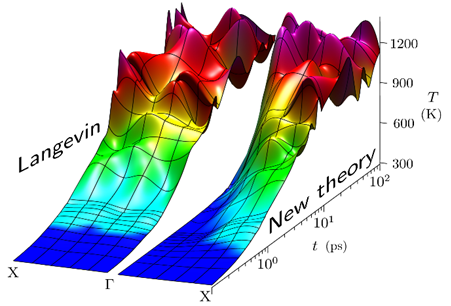 Comparison of simulated heating of atomic vibrations by excited electrons evolved using standard Langevin dynamics that relax all modes indiscriminately, regardless of their wavelength (left), with simulated heating using new dynamics that account for the spatially correlated electron–phonon coupling strength and better capture the complexity of electron–ion thermal equilibration (right). |
A multi-institutional team that includes Artur Tamm and Alfredo Correa has established a novel type of dynamics to model electron-ion coupling at the atomic scale in solids and liquids with collective vibrational modes. Effects resulting from electronic excitations can henceforth be incorporated seamlessly in molecular dynamics models to correctly simulate the aftermath of ionizing radiation events, including electronic energy dissipation, phonon relaxation lifetimes, and temperature equilibration processes.
This theoretical development in the field of statistical mechanics enables modeling of fast (femtosecond) interactions of ions and electrons. The theory is derived from basic physics principles but still achieves the complexity required to realistically model the relaxation of systems. By applying the new model to nickel and complex alloys, the team has shown that electrons excited above their ground states (e.g., after laser ablation or particle irradiation) heat various vibrational modes at different rates. This result contrasts with traditional Langevin dynamics, which damp all motion equally and therefore fail to sufficiently capture the influence of excited electrons. Incorporating differential heating into the new model has observable consequences critical to understanding radiation damage, energy dissipation, and defect evolution in chemically complex alloys.
The paper detailing these findings has been selected as an “Editor’s suggestion” by the journal Physical Review Letters. [A. Tamm, M. Caro, A. Caro, G. Samolyuk, M. Klintenberg, and A.A. Correa, "Langevin dynamics with spatial correlations as a model for electron-phonon coupling," Physical Review Letters 120, 185501 (2018).]
